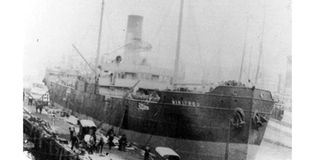Hoyle: Missionary who saw Kampala city change faces

The SS Winfred steamer ferry on Lake Victoria in Entebbe in 1903. It is aboard this ferry that WE Hoyle arrived in Uganda. Courtesy Photos
What you need to know:
Memories. In 1903, SS Winfred Steamer anchored at Port Florence, now Katabi in Entebbe. Among the passengers was WE Hoyle, who founded the Uganda Company, which evolved into Uganda Development Corporation. In Volume 4 of the 1949 Uganda Journal, Hoyle narrates his first impressions of Kampala. Henry Lubega accessed the publication and picked extracts from Hoyle’s story.
I arrived in 1903, on SS Winfred steamer’s third voyage to Entebbe. The road from Entebbe to Kampala was known as the ‘Porters’ Road. At the time, there were three major means of travel from Entebbe to Kampala, including walking, being carried in a hammock, or riding a bicycle. Being energetic and young, I decided to use the push bike (bicycle). The distance from Entebbe to Kampala was said to be 19 miles.
In company of another European living in Kampala, we decided to make the journey by night, with the light of full moon. It was rather a gruelling introduction to an African road with rough surfaces, ruts and swampy ground, which involved carrying the bicycle in some places. We reached Kampala at midnight and bed never seemed more welcome.
My first view of Kampala was of thrilling interest from the fort established by Captain Lugard. From the fort, one surveyed the township down the gentle slope of the hill with Indian Dukas thronged by Indians and Baganda. I soon discovered that to the Europeans, the most important store was that of Allidina Visram. Existence almost depended on this store. Visram’s prices were difficult to understand, some were exceedingly dear and some very cheap. Jams, for instance, imported in one-pound tins, arrived about twice a year, and it did not matter whether the contents were strawberry, raspberry or red currant jelly, the price was the same.

WE Hoyle (3rd R, front row) squats next to Kabaka Daudi Chwa during the young king’s seventh birthday celebrations at Lubiri on August 8, 1903.
The currency throughout East Africa and Uganda was Indian rupees, Annas pice and Pies. The most generally used currency in Uganda was Cowrie shells, through which a hole had been made for threading. The Baganda were extraordinarily adept at counting shells, usually strung in hundreds using ebyayi (banana fibers).
Apart from the Church Missionary Society and the Roman Catholic Missionaries, the European population in Kampala in 1903, was about nine men and one woman. But there was a bigger population in Entebbe, which was then regarded as the “metropolis” of Uganda.
A year after my arrival, a new Porter’s road between Kampala and Entebbe came into use. It was four miles longer than the old one I had used on my maiden journey to Kampala. It was more levelled and one could cycle to Entebbe and back on the same day.
Kabaka’s birthday
On August 8, 1903, I attended the infant Kabaka Daudi Chwa’s seventh birthday at Lubiri. All the few Kampala-based Europeans were invited to join the celebrations and partake of the fare provided, which included chiefly cakes, biscuits and lemonade. A special guard of honour of the Indian contingent appeared and was duly inspected by the young king, who solemnly walked around holding John Sturrock, his tutor’s hand. As we said our goodbye to the young king, he would quietly murmur Mwebale basebo (thank you sirs).”




